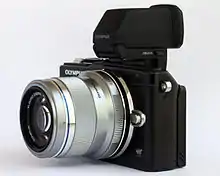Electronic viewfinder
An electronic viewfinder (EVF) is a camera viewfinder where the image captured by the lens is projected electronically onto a miniature display. The image on this display is used to assist in aiming the camera at the scene to be photographed. It differs from a live preview screen in being smaller and shaded from ambient light, and may also use less power. The sensor records the view through the lens, the view is processed, and finally projected on a miniature display which is viewable through the eyepiece. Electronic viewfinders are used in digital still cameras and in video cameras. Some cameras (such as Panasonic, Sony, Fujifilm) have an automatic eye sensor which switches the display from screen to EVF when the viewfinder is near the eye. More modest cameras use a button to switch the display. Some have no button at all.[1]



To get the advantage of both optical and electronic viewfinders some cameras have hybrid viewfinders. These display the image in an optical eyepiece viewfinder, or electronically on an LCD screen. Examples include some Fujifilm X-series cameras.
References
- Darren Rowse. "Should I use the LCD or Viewfinder on my Digital Camera?". Retrieved February 11, 2015.